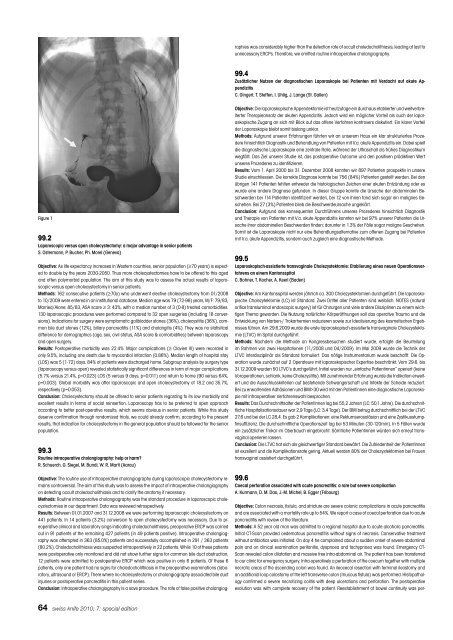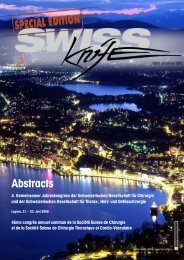Anorectal Manometry in 3D NEW! - Swiss-knife.org
Anorectal Manometry in 3D NEW! - Swiss-knife.org
Anorectal Manometry in 3D NEW! - Swiss-knife.org
You also want an ePaper? Increase the reach of your titles
YUMPU automatically turns print PDFs into web optimized ePapers that Google loves.
Figure 1<br />
99.2<br />
Laparoscopic versus open cholecystectomy: a major advantage <strong>in</strong> senior patients<br />
S. Ostermann, P. Bucher, Ph. Morel (Geneva)<br />
Objective: As life expectancy <strong>in</strong>creases <strong>in</strong> Western countries, senior population (≥70 years) is expected<br />
to double by the years 2030-2050. Thus more cholecystectomies have to be offered to this aged<br />
and often polymorbid population. The aim of this study was to assess the actual results of laparoscopic<br />
versus open cholecystectomy <strong>in</strong> senior patients.<br />
Methods: 162 consecutive patients (≥70y) who underwent elective cholecystectomy from 01/2008<br />
to 10/2009 were entered <strong>in</strong> an <strong>in</strong>stitutional database. Median age was 79 (72-98) years, M/F: 79/83,<br />
Married/Alone: 85/83, ASA score ≥ 3: 43%, with a median number of 3 (0-8) treated comorbidities.<br />
130 laparoscopic procedures were performed compared to 32 open surgeries (<strong>in</strong>clud<strong>in</strong>g 18 conversions).<br />
Indications for surgery were symptomatic gallbladder stones (36%), cholecystitis (36%), common<br />
bile duct stones (12%), biliary pancreatitis (11%) and cholangitis (4%). They was no statistical<br />
difference for demographics (age, sex, civil status, ASA score & comorbidities) between laparoscopy<br />
and open surgery.<br />
Results: Postoperative morbidity was 22.4%. Major complications (≥ Clavien III) were recorded <strong>in</strong><br />
only 9.5%, <strong>in</strong>clud<strong>in</strong>g one death due to myocardial <strong>in</strong>farction (0.86%). Median length of hospital stay<br />
(LOS) was 5 (1-72) days. 84% of patients were discharged home. Subgroup analysis by surgery type<br />
(laparoscopy versus open) revealed statistically significant differences <strong>in</strong> term of major complications<br />
(5.7% versus 21.4%, p=0.023) LOS (5 versus 9 days, p=0.011) and return to home (90 versus 64%,<br />
p=0.003). Global morbidity was after laparoscopic and open cholecystectomy of 18.2 and 35.7%,<br />
respectively (p=0.053).<br />
Conclusion: Cholecystectomy should be offered to senior patients regard<strong>in</strong>g to its low morbidity and<br />
excellent results <strong>in</strong> terms of social re<strong>in</strong>sertion. Laparoscopy has to be preferred to open approach<br />
accord<strong>in</strong>g to better post-operative results, which seems obvious <strong>in</strong> senior patients. While this study<br />
deserve confirmation through randomized trials, we could already confirm, accord<strong>in</strong>g to the present<br />
results, that <strong>in</strong>dication for cholecystectomy <strong>in</strong> the general population should be followed for the senior<br />
population.<br />
99.3<br />
Rout<strong>in</strong>e <strong>in</strong>traoperative cholangiography: help or harm?<br />
R. Schuerch, G. Siegel, M. Bundi, W. R. Marti (Aarau)<br />
Objective: The rout<strong>in</strong>e use of <strong>in</strong>traoperative cholangiography dur<strong>in</strong>g laparoscopic cholecystectomy rema<strong>in</strong>s<br />
controversial. The aim of this study was to assess the impact of <strong>in</strong>traoperative cholangiography<br />
on detect<strong>in</strong>g occult choledocholithiasis and to clarify the anatomy if necessary.<br />
Methods: Rout<strong>in</strong>e <strong>in</strong>traoperative cholangiography was the standard procedure <strong>in</strong> laparoscopic cholecystectomies<br />
<strong>in</strong> our department. Data was reviewed retrospectively.<br />
Results: Between 01.01.2007 and 31.12.2008 we were perform<strong>in</strong>g laparoscopic cholecystectomy on<br />
441 patients. In 14 patients (3.2%) conversion to open cholecystectomy was necessary. Due to preoperative<br />
cl<strong>in</strong>ical and laboratory s<strong>in</strong>gs <strong>in</strong>dicat<strong>in</strong>g choledocholithiasis, preoperative ERCP was carried<br />
out <strong>in</strong> 91 patients of the rema<strong>in</strong><strong>in</strong>g 427 patients (<strong>in</strong> 49 patients positive). Intraoperative cholangiography<br />
was attempted <strong>in</strong> 363 (85.0%) patients and successfully accomplished <strong>in</strong> 291 / 363 patients<br />
(80.2%). Choledocholithiasis was suspected <strong>in</strong>traoperatively <strong>in</strong> 22 patients. While 10 of these patients<br />
were postoperative only monitored and did not show further signs for common bile duct obstruction,<br />
12 patients were admitted to postoperative ERCP which was positive <strong>in</strong> only 6 patients. Of these 6<br />
patients, only one patient had no signs for choledocholithiasis <strong>in</strong> the preoperative exam<strong>in</strong>ations (laboratory,<br />
ultrasound or ERCP). There where no cholecystectomy or cholangiography associated bile duct<br />
<strong>in</strong>juries or postoperative pancreatitis <strong>in</strong> this patient series.<br />
Conclusion: Intraoperative cholangiography is a save procedure. The rate of false positive cholangiog-<br />
64 swiss <strong>knife</strong> 2010; 7: special edition<br />
raphies was considerably higher than the detection rate of occult choledocholithiasis, lead<strong>in</strong>g at last to<br />
unnecessary ERCPs. Therefore, we omitted rout<strong>in</strong>e <strong>in</strong>traoperative cholangiography.<br />
99.4<br />
Zusätzlicher Nutzen der diagnostischen Laparaskopie bei Patienten mit Verdacht auf akute Appendizitis<br />
C. G<strong>in</strong>gert, T. Steffen, I. Uhlig, J. Lange (St. Gallen)<br />
Objective: Die laparaskopische Appendektomie ist heutzutage e<strong>in</strong> durchaus etablierter und weitverbreiterter<br />
Therapieansatz der akuten Appendizitis. Jedoch wird e<strong>in</strong> möglicher Vorteil als auch der laparaskopische<br />
Zugang an sich mit Blick auf das offene Verfahren kontrovers diskutiert. E<strong>in</strong> klarer Vorteil<br />
der Laparaskopie bleibt somit bislang unklar.<br />
Methods: Aufgrund unserer Erfahrungen führten wir an unserem Haus e<strong>in</strong> klar strukturiertes Prozedere<br />
h<strong>in</strong>sichtlich Diagnostik und Behandlung von Patienten mit V.a. akute Appendizitis e<strong>in</strong>. Dabei spielt<br />
die diagnostische Laparaskopie e<strong>in</strong>e zentrale Rolle, während der Ultraschall als frühes Diagnostikum<br />
wegfällt. Das Ziel unserer Studie ist, das postoperative Outcome und den positiven prädiktiven Wert<br />
unseres Prozederes zu identifizieren.<br />
Results: Vom 1. April 2000 bis 31. Dezember 2008 konnten wir 897 Patienten prospektiv <strong>in</strong> unsere<br />
Studie e<strong>in</strong>schliessen. Die korrekte Diagnose konnte bei 756 (84%) Patienten gestellt werden. Bei den<br />
übrigen 141 Patienten fehlten entweder die histologischen Zeichen e<strong>in</strong>er akuten Entzündung oder es<br />
wurde e<strong>in</strong>e andere Diagnose gefunden. In dieser Gruppe konnte die Ursache der abdom<strong>in</strong>alen Beschwerden<br />
bei 114 Patienten identifiziert werden, bei 12 von ihnen fand sich sogar e<strong>in</strong> malignes Geschehen.<br />
Bei 27 (3%) Patienten blieb die Beschwerdeursache ungeklärt.<br />
Conclusion: Aufgrund des konsequenten Durchführens unseres Prozederes h<strong>in</strong>sichtlich Diagnostik<br />
und Therapie von Patienten mit V.a. akute Appendizitis konnten wir bei 97% unserer Patienten die Ursache<br />
ihrer abdom<strong>in</strong>ellen Beschwerden f<strong>in</strong>den; darunter <strong>in</strong> 1.3% der Fälle sogar maligne Geschehen.<br />
Somit ist die Laparaskopie nicht nur e<strong>in</strong>e Behandlungsalternative zum offenen Zugang bei Patienten<br />
mit V.a. akute Appendizitis, sondern auch zugleich e<strong>in</strong>e diagnostische Methode.<br />
99.5<br />
Laparoskopisch-assistierte transvag<strong>in</strong>ale Cholezystektomie: Etablierung e<strong>in</strong>es neuen Operationsverfahrens<br />
an e<strong>in</strong>em Kantonsspital<br />
C. Bohner, T. Kocher, A. Keerl (Baden)<br />
Objective: Am Kantonsspital werden jährlich ca. 300 Cholezystektomien durchgeführt. Die laparoskopische<br />
Cholezytektomie (LC) ist Standard. Zwei Drittel aller Patienten s<strong>in</strong>d weiblich. NOTES (natural<br />
orifice translum<strong>in</strong>al endoscopic surgery) ist für Chirurgen und viele andere Diszipl<strong>in</strong>en zu e<strong>in</strong>em wichtigen<br />
Thema geworden. Die Nutzung natürlicher Körperöffnungen soll das operative Trauma und die<br />
Entwicklung von Narben-/ Trokarhernien reduzieren sowie zur Idealisierung des kosmetischen Ergebnisses<br />
führen. Am 29.6.2009 wurde die erste laparoskopisch-assistierte transvag<strong>in</strong>ale Cholezystektomie<br />
(LTVC) im Spital durchgeführt.<br />
Methods: Nachdem die Methode an Kongressbesuchen studiert wurde, erfolgte die Beurteilung<br />
im Rahmen von zwei Hospitationen (11/2008 und 04/2009). Im Mai 2009 wurde die Technik der<br />
LTVC <strong>in</strong>terdiszipl<strong>in</strong>är als Standard formuliert. Das nötige Instrumentarium wurde beschafft. Die Operation<br />
wurde zunächst auf 2 Operateure mit laparoskopischer Expertise beschränkt. Vom 29.6. bis<br />
31.12.2009 wurden 50 LTVC’s durchgeführt. Initial wurden nur „e<strong>in</strong>fache Patient<strong>in</strong>nen“ operiert (ke<strong>in</strong>e<br />
Voroperationen, schlank, ke<strong>in</strong>e Cholezystitis). Mit zunehmender Erfahrung wurde die Indikation erweitert<br />
und die Ausschlusskriterien auf bestehende Schwangerschaft und Infekte der Scheide reduziert.<br />
Bei zu erwartenden Adhäsionen und BMI>30 wird mit den Patient<strong>in</strong>nen e<strong>in</strong>e diagnostische Laparoskopie<br />
mit <strong>in</strong>traoperativer Verfahrenswahl besprochen.<br />
Results: Das Durchschnittsalter der Patient<strong>in</strong>nen lag bei 55,2 Jahren (LC: 50,1 Jahre). Die durchschnittliche<br />
Hospitalisationsdauer war 2,9 Tage (LC: 3,4 Tage). Der BMI betrug durchschnittlich bei der LTVC<br />
27,6 und bei der LC 28,4. Es gab 2 Komplikationen: e<strong>in</strong>e Rektumserosaläsion und e<strong>in</strong>e Zystikusstumpf<strong>in</strong>suffizienz.<br />
Die durchschnittliche Operationszeit lag bei 53 M<strong>in</strong>uten (30-120m<strong>in</strong>). In 5 Fällen wurde<br />
e<strong>in</strong> zusätzlicher Trokar im Oberbauch e<strong>in</strong>gebracht. Sämtliche Patient<strong>in</strong>nen würden sich erneut transvag<strong>in</strong>al<br />
operieren lassen.<br />
Conclusion: Die LTVC hat sich als gleichwertiger Standard bewährt. Die Zufriedenheit der Patient<strong>in</strong>nen<br />
ist exzellent und die Komplikationsrate ger<strong>in</strong>g. Aktuell werden 80% der Cholezystektomien bei Frauen<br />
transvag<strong>in</strong>al assistiert durchgeführt.<br />
99.6<br />
Coecal perforation associated with acute pancreatitis: a rare but severe complication<br />
A. Kurmann, D. M. Dao, J.-M. Michel, B. Egger (Fribourg)<br />
Objective: Colon necrosis, fistula, and stricture are severe colonic complications <strong>in</strong> acute pancreatitis<br />
and are associated with a mortality rate up to 54%. We report a case of coecal perforation due to acute<br />
pancreatitis with review of the literature.<br />
Methods: A 52 year old man was admitted to a regional hospital due to acute alcoholic pancreatitis.<br />
Initial CT-Scan provided oedematous pancreatitis without signs of necrosis. Conservative treatment<br />
without antibiotics was <strong>in</strong>itiated. On day 4 he compla<strong>in</strong>ed about a sudden onset of severe abdom<strong>in</strong>al<br />
pa<strong>in</strong> and on cl<strong>in</strong>ical exam<strong>in</strong>ation peritonitis, dyspnoea and tachypnoea was found. Emergency CT-<br />
Scan revealed colon dilatation and massive free <strong>in</strong>tra-abdom<strong>in</strong>al air. The patient has been transferred<br />
to our cl<strong>in</strong>ic for emergency surgery. Intra-operatively a perforation of the coecum together with multiple<br />
necrotic areas of the ascend<strong>in</strong>g colon was found. An ileocecal resection with term<strong>in</strong>al ileostomy and<br />
an additional loop colostomy of the left transverse colon (mucous fistula) was performed. Histopathology<br />
confirmed a severe necrotiz<strong>in</strong>g colitis with deep ulcerations and perforation. The postoperative<br />
evolution was with complete recovery of the patient. Reestablishment of bowel cont<strong>in</strong>uity was per-
















